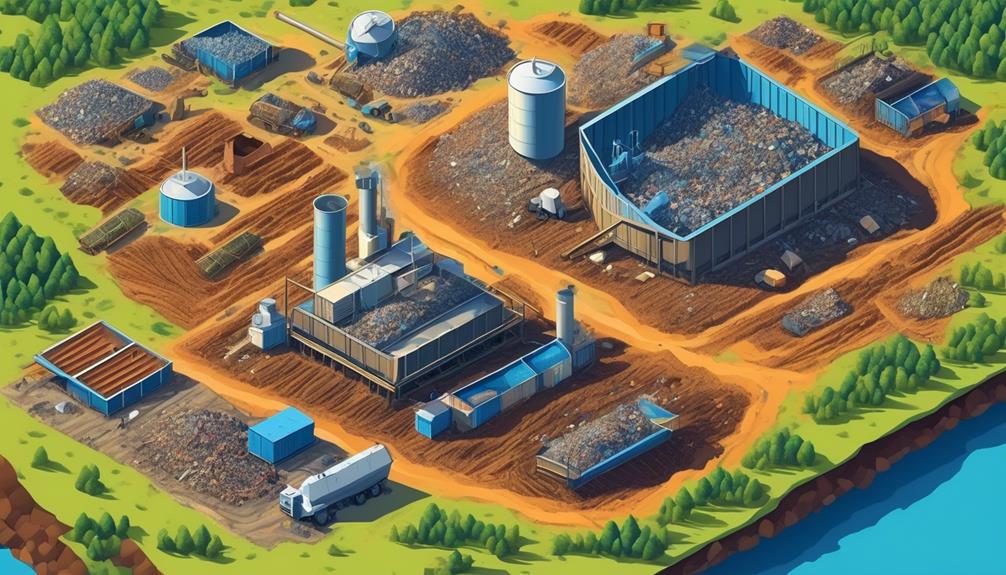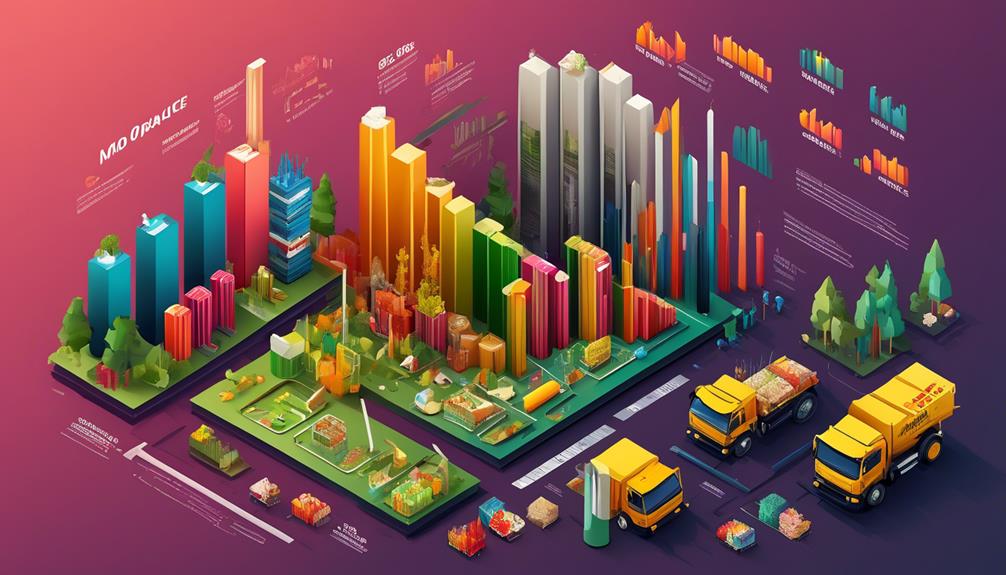Waste statistics are like a map, guiding us through the intricate landscape of our consumption and disposal habits. They offer a glimpse into the scale and impact of our waste generation, revealing patterns and trends that shape our environmental footprint.
But these numbers are more than just figures on a page; they hold the key to understanding the urgent need for sustainable waste management practices and the global challenges that come with it.
Join me as we unravel the intricate web of waste statistics and discover the insights they hold for a cleaner, greener future.
Key Takeaways
- Municipal solid waste (MSW) production in the United States has consistently increased since 1990, reaching 292.4 million tons in 2018.
- Plastic product generation has surged to 35.7 million tons in 2018.
- Per capita MSW generation increased from 4.5 pounds per person per day in 2017 to 4.9 pounds per person per day in 2018.
- Global waste generation is projected to more than double population growth by 2050, reaching 3.40 billion tonnes.
National Waste Generation Trends
The national waste generation trends in the United States reflect a consistent increase in municipal solid waste (MSW) production since 1990. In 2018, the total generation of MSW reached a staggering 292.4 million tons, marking a significant rise over the years.
Interestingly, while paper and paperboard products in MSW declined from 87.7 million tons in 2000 to 67.4 million tons in 2018, the generation of plastic products surged to 35.7 million tons in 2018. This shift in the composition of waste materials signifies the evolving nature of our consumption patterns.
Moreover, on a per capita basis, MSW generation increased from 4.5 pounds per person per day in 2017 to 4.9 pounds per person per day in 2018, further highlighting the escalating trend.
Despite this surge, recycling and composting accounted for almost 94 million tons, showcasing a growing awareness and effort towards sustainable waste management. However, landfilling of MSW in 2018 still amounted to approximately 146.1 million tons, with food being the largest component landfilled at about 24%.
These statistics underscore the need for continued initiatives to reduce, reuse, and recycle in order to curb the escalating waste generation trends.
Global Waste Production Analysis

Global waste production has been on the rise, with municipal solid waste generation reaching a staggering 292.4 million tons in 2018. This increase has had a significant impact on the environment, leading to the release of over 193 million metric tons of carbon dioxide equivalent.
As we analyze these trends, it becomes imperative to explore strategies for waste reduction to mitigate the environmental consequences.
Waste Generation Trends
Analyzing waste generation trends provides valuable insights into the environmental impact of human activity and the urgency of implementing sustainable waste management practices. The statistics reveal concerning trends:
- Global municipal solid waste (MSW) generation was 2.01 billion tonnes in 2018, projected to reach 3.40 billion tonnes by 2050.
- Per capita waste generated per day averages 0.74 kilograms globally, with high-income countries responsible for about 34% of the world's waste generation.
- Waste generation is increasing rapidly worldwide, with a projection that by 2050, global waste generation will more than double the population growth.
Understanding these trends highlights the critical need for effective waste management strategies to mitigate environmental and health impacts. It's evident that education and awareness campaigns are essential to prioritize proper waste management, including recycling, composting, and waste-to-energy technologies.
Impact on Environment
Studying waste production analysis on a global scale reveals significant insights into its environmental impact and the urgency of implementing sustainable waste management practices.
With global waste generation projected to double population growth by 2050, the environmental implications are substantial. Municipal solid waste (MSW) alone amounts to 2.01 billion tonnes annually, with a significant portion not managed in an environmentally safe manner.
However, recycling and composting efforts have shown promise, saving over 193 million metric tons of carbon dioxide equivalent in 2018. Disparities in waste management infrastructure between high and low-income countries further exacerbate environmental challenges.
To mitigate these impacts, emphasis on waste reduction, recycling, and composting is crucial. Additionally, investments in waste-to-energy technologies offer opportunities to generate renewable energy.
Addressing these environmental concerns necessitates a concerted global effort towards sustainable waste management practices.
Strategies for Reduction
Waste reduction and prevention strategies are essential for addressing the global challenge of waste production.
To effectively tackle this issue, we can promote waste reduction and prevention through education and awareness campaigns.
Encouraging recycling and composting can significantly minimize the amount of waste sent to landfills.
Additionally, investing in waste-to-energy technologies not only helps in generating renewable energy but also reduces the volume of waste destined for landfills.
Collaboration between governments, the private sector, and communities is crucial for an effective waste management system.
Impact of Waste on Greenhouse Gas Emissions

Reducing food waste is crucial for mitigating greenhouse gas emissions and promoting sustainable waste management practices. The impact of waste on greenhouse gas emissions is significant, with 1.6 billion tonnes of CO2 equivalent emissions generated from solid waste treatment and disposal in 2016.
However, effective waste management strategies such as recycling, composting, and waste-to-energy technologies have shown promise. In 2018, these methods saved over 193 million metric tons of carbon dioxide equivalent, which is comparable to removing almost 42 million cars from the road for a year. Notably, paper and paperboard recycling contributed the most to this reduction, accounting for over 46 million tons.
Food waste alone accounts for nearly 50% of the greenhouse gas emissions from solid waste treatment and disposal. Therefore, it's imperative to prioritize proper waste management and reduction strategies to mitigate environmental and health impacts while also curbing greenhouse gas emissions.
These efforts are pivotal in fostering a more sustainable and eco-friendly approach to waste management.
Municipal Waste Management Figures

In 2018, a total of 292.4 million tons of municipal solid waste (MSW) were generated, with a significant increase in per capita MSW generation from the previous year.
The recycling and composting of MSW played a crucial role in waste management, with over 69 million tons of MSW recycled and 25 million tons composted.
Additionally, landfilling and combustion with energy recovery were responsible for the disposal of a substantial portion of MSW.
Waste Generation Rates
Surprisingly, the municipal waste generation rate in the United States reached 292.4 million tons in 2018, with an average per capita generation of 4.9 pounds per person per day. This high level of waste production poses significant environmental challenges.
In 2018, paper and paperboard products accounted for the largest percentage of total waste generation, followed by a notable increase in plastic products generation. Despite this, over 69 million tons of municipal solid waste (MSW) were recycled, with paper and paperboard products comprising the majority.
Additionally, various waste management methods, including recycling, composting, combustion with energy recovery, and landfilling, saved over 193 million metric tons of carbon dioxide equivalent (MMTCO2E), highlighting the positive impact of sustainable waste management practices.
Recycling Rates
The significant amount of waste generated in the United States presents a pressing need to examine the recycling rates as a crucial aspect of municipal waste management figures.
In 2018, the recycling rate was 32.1%, with over 69 million tons of municipal solid waste being recycled. Notably, paper and paperboard products accounted for approximately 67% of the recycled amount.
While the recycling rate grew significantly until 2005, its growth has slowed in recent years. However, there have been positive developments, such as the yard trimmings composting rate increasing from negligible in 1980 to 63% in 2018.
Overall, recycling and composting of MSW in 2018 accounted for almost 94 million tons, with an additional 17.7 million tons of other food management.
These figures highlight both progress and areas for further improvement in municipal waste management.
Alarming Statistics About Plastic Waste

Alarmingly, the generation of plastic products increased from 2010 to 2018, reaching 35.7 million tons. This surge in plastic production has led to a myriad of concerning statistics that highlight the severity of the plastic waste crisis.
Firstly, despite the growing volume of plastic waste, the recycling rate in the US for solid municipal waste was only 32.1% in 2018.
Additionally, the impact of China's 2018 restrictions on the import of American recyclables has been substantial, as China was previously importing about 45% of America's paper, plastics, and other recyclables.
Lastly, the global recycling rate is dismally low, with only 13% of trash being recycled worldwide.
These statistics underscore the urgent need for effective measures to address the plastic waste epidemic. Without significant improvements in recycling rates and waste management practices, the projected 1.3 billion tons of plastic waste in the environment by 2040 will have devastating consequences for our planet.
Recycling and Energy Conservation Data
The increase in recycling and composting rates for specific materials over the years has contributed to substantial energy conservation and carbon dioxide equivalent savings. In 2018 alone, 193 million metric tons of carbon dioxide equivalent were saved, reflecting the positive impact of recycling efforts.
In that same year, a total of over 69 million tons of municipal solid waste (MSW) were recycled, with approximately 25 million tons being composted. Paper and paperboard, which made up about 67% of the recycled amount, played a crucial role in these efforts.
Overall, in 2018, almost 94 million tons of MSW were recycled and composted, with an additional 17.7 million tons managed through other food management pathways. These sustainable waste management practices not only reduced the burden on landfills but also resulted in significant environmental benefits.
The carbon dioxide equivalent savings from recycling, composting, combustion with energy recovery, and landfilling of MSW in 2018 were equivalent to taking almost 42 million cars off the road for a year.
These statistics underscore the importance of continued focus on recycling and composting for energy conservation and environmental preservation.
Waste Management Challenges and Solutions

Addressing waste management challenges requires innovative solutions and proactive collaboration across various sectors. As we strive to tackle the escalating waste generation, it's crucial to implement effective strategies.
- Promoting Circular Economy: Encouraging a circular economy can significantly reduce waste by designing products for reuse, recycling, and remanufacturing. This approach minimizes the extraction of raw materials and lessens the burden on landfills.
- Investing in Advanced Recycling Technologies: Embracing advanced recycling technologies such as chemical recycling and pyrolysis can help manage non-recyclable plastics and other waste materials effectively. These innovations contribute to reducing the amount of waste destined for landfills.
- Enhancing Public Awareness and Participation: Educating individuals about proper waste management practices and fostering their active participation in recycling and composting initiatives is vital. Increased public awareness can lead to higher recycling rates and a reduction in the amount of waste sent to landfills.
Frequently Asked Questions
What Are the Main Sources of Industrial Waste in the United States?
The main sources of industrial waste in the United States are manufacturing processes, construction and demolition activities, energy sector operations, agricultural activities, and healthcare facilities. These contribute to the generation of various types of industrial waste.
How Does Waste Management Differ in Developing Countries Compared to Developed Nations?
In developing countries, waste management faces challenges due to limited infrastructure and resources, leading to informal collection and open dumping. In contrast, developed nations have advanced systems with higher recycling rates and strict regulations.
What Are the Long-Term Effects of Plastic Waste on Marine Life and Ecosystems?
The long-term effects of plastic waste on marine life and ecosystems include bioaccumulation of toxins, leading to disruption of natural processes, harm to marine animals, and potential risks to human health through the food chain.
Are There Any Innovative Solutions Being Developed to Address the Issue of Electronic Waste?
Yes, there are innovative solutions being developed to address electronic waste. Advanced recycling technologies, biodegradable electronics, and a circular economy approach are being explored. Blockchain technology and collaborative initiatives aim to establish global standards for e-waste management and recycling.
How Do Different Cultural Attitudes Towards Waste Impact Global Waste Production?
Different cultural attitudes towards waste impact global waste production by influencing habits, recycling practices, and landfilling rates. Prioritizing convenience and disposable products results in more waste, while thrift and resourcefulness lead to lower levels of waste generation.
Conclusion
In conclusion, when it comes to waste statistics, the numbers don't lie. From the mountains of plastic waste to the rising greenhouse gas emissions, it's clear that we've some serious challenges ahead.
But by facing these challenges head-on and implementing innovative solutions, we can turn the tide on waste generation and create a more sustainable future for our planet.
It's time to take out the trash and make a real difference.










